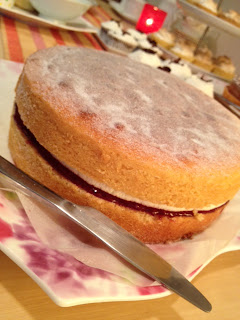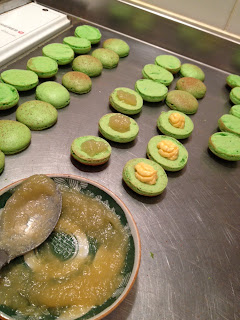A friend asked me to do the desserts for her sayonara tea-party. Apart from being able to contribute
something nice for my friend’s special day, I thought it would also be a good
chance to practice a bit of the time-management and planning side of running a
food business.
The order included a couple of Victoria sponge cakes, 2 dozen cupcakes,
shortbread jam heart biscuits, some gluten-free chocolate sparkle cookies and a
couple of carrot cakes. Oh! And 20 mini lemon meringues. I also did a few mini scones to be had with the rest of the jam.
It was quite a challenge trying to complete this order in my tiny 1-shelf oven, which necessitated the making of things in very small batches. That’s right folks, jammy heart sandwich cookies can only be made 6 at a time – that’s 6 halves at a time, and so an order of 20 take 7 trips to the oven.. and all the layer cakes have to be made a layer at a time too.. goodness.
It was quite a challenge trying to complete this order in my tiny 1-shelf oven, which necessitated the making of things in very small batches. That’s right folks, jammy heart sandwich cookies can only be made 6 at a time – that’s 6 halves at a time, and so an order of 20 take 7 trips to the oven.. and all the layer cakes have to be made a layer at a time too.. goodness.
Advance calculations I made estimating the time needed to prepare and bake the order came to about 24 hours (!). This was mainly due to the aforementioned diddy oven issue, but also because there is a lot of variation in the order as opposed to bulk production of the same thing. Just to be on the safe side I very happily took a day off my office work and also got a head-start on some things the night before the main production day. Tomas Haas' chocolate sparkle cookie dough for example, needed to be chilled overnight anyway.
I had images of my (also tiny) home kitchen looking like a bomb-site, and
surfaces around the house needing to be stacked with various cooling and
packed-up goodies, but in the end tidying up as I finished each part meant it wasn't unmanageable. With the help of decent sized cake boxes, large Tupperware and a couple of large IKEA bags, I was also able to transport the whole order (and two bottles of bubbly) by taxi with the help of a friend. We also managed to avoid
throwing the whole lot on the pavement outside the party girl’s flat, another
image I’d been trying to push out of my mind. One other thing I learned is that being on your feet all day is hard! I'll have to start physical training for my transition from office job to baker. :)
Since there were 2 of each full-sized cake I decided to do something a bit
different with each. One of the carrot cakes was made with walnuts and the other
with pecans.
I did a traditional Victoria sponge that just had jam inside (home made strawberry champagne jam), and another with raspberry jam and chantilly cream.
Half the cupcakes were in my friend’s favourite style, with a cream cheese frosting topped with blueberries and edible flowers, and the other half were moist chocolate cakes with a dollop of ganache in the center, topped with a simple vanilla butter cream frosting and curls of dark chocolate.
All in all it went very well! There was plenty to go around and people enjoyed having something ‘nastukashii’ or nostalgic aside from just cupcakes, there was talk of Grandmothers and time in the kitchen as a child. Japanese friends got to try things like the Victoria sponges that they’d seen in recipe books but not tasted before. Everyone ate too much cake... hmm.
There were a couple of things I’d do differently – not pipe the meringue down into the pastry cases to avoid a couple of them cracking on expansion of the meringue, and maybe a thicker filling to the carrot cakes, but my friend was thrilled and I was happy with the items I took. Definitely be easier with a more professional kitchen. ;)
I did a traditional Victoria sponge that just had jam inside (home made strawberry champagne jam), and another with raspberry jam and chantilly cream.
 |
| Victoria sponge cake, a classic |
 |
| The more traditional filling, with an experimental decoration |
 |
| Sift icing sugar through doily, remove carefully! |
Half the cupcakes were in my friend’s favourite style, with a cream cheese frosting topped with blueberries and edible flowers, and the other half were moist chocolate cakes with a dollop of ganache in the center, topped with a simple vanilla butter cream frosting and curls of dark chocolate.
All in all it went very well! There was plenty to go around and people enjoyed having something ‘nastukashii’ or nostalgic aside from just cupcakes, there was talk of Grandmothers and time in the kitchen as a child. Japanese friends got to try things like the Victoria sponges that they’d seen in recipe books but not tasted before. Everyone ate too much cake... hmm.
 |
| Natsukashii! |
There were a couple of things I’d do differently – not pipe the meringue down into the pastry cases to avoid a couple of them cracking on expansion of the meringue, and maybe a thicker filling to the carrot cakes, but my friend was thrilled and I was happy with the items I took. Definitely be easier with a more professional kitchen. ;)























